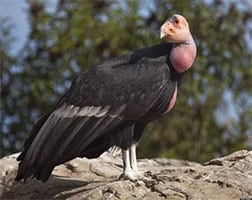 The etymological origin of condor is found in the Quechua word cúntur . A condor is a bird of prey whose habitat is in the Andean region. This animal belongs to the catartiform family group.
The etymological origin of condor is found in the Quechua word cúntur . A condor is a bird of prey whose habitat is in the Andean region. This animal belongs to the catartiform family group.
One of the characteristics of the condor is that it does not have subspecies, that is, its species is not divided into groups of individuals that present characteristics that distinguish them from other groups. As with many other animals, although not with most birds of prey, the male is larger than the female.
The condor can have a wingspan of about three meters, with a length of more than one meter. That is why it is considered the largest bird among those that have the ability to fly. Only the royal albatross and the traveler can surpass it in wingspan, although the condor weighs more, is more robust and taller than them.
These animals have their bodies covered in black feathers , except for certain sectors of the wings and neck, which are white. The head of the condor, on the other hand, is not covered with feathers and exhibits a reddish hue that can vary.
This bird builds its nests at a height of over 1000 meters , and can reach up to 5000 meters . The destruction of its habitat by humans is one of the factors that cause the condor to be considered a "near threatened species" : that is, it faces a certain risk to its subsistence.
Near Threatened species (a term that usually appears as NT , the abbreviation of the English version of the name, Near Threatened ) do not meet the criteria to be considered "critically endangered ", "endangered" or "vulnerable", the categories of the called Red List carried out by the IUCN ( International Union for Conservation of Nature ), although it is expected that sooner or later it will do so due to not being in favorable conditions.
Hunting, the ingestion of poisoned animals and baits placed illegally by some ranchers and hunters, and its low reproduction rate (it is estimated that it lays only one egg every two years) also have a negative impact on the development of the species , which It stands out for its great longevity (it can live about 75 years). To counteract this decline in the condor population, several nations carry out captive breeding programs.
 As the condor can live such a long life, its sexual maturity only appears at eight years of age, and this also plays a negative role in its subsistence, given the harmful actions of human beings, both direct and indirect.
As the condor can live such a long life, its sexual maturity only appears at eight years of age, and this also plays a negative role in its subsistence, given the harmful actions of human beings, both direct and indirect.
It should be noted that the condor has great cultural and symbolic importance in the native peoples of the Andes . Some cultures held that condors were immortal and others considered them as messengers who brought omens. In Bolivia , Ecuador , Colombia , Chile and Peru , the condor is a national symbol.
In 1758, a Swedish scientist named Carlos Linnaeus described the Andean condor in the tenth installment of Systema naturae with the binominal nomenclature Vultur gryphus , which he maintains today. The first of these terms comes from the Latin voltur or vultur , which means "vulture", while the second derives from the ancient Greek γρυπός , which means "hooked beak ."
The Andean condor is related to the California condor and the royal condor (also known as the jungle condor , among several other names). The royal condor is its closest relative from a genetic point of view; so much so, that several authors have placed these two species in a subfamily, apart from the other American vultures.
